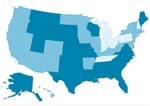government
Appeals court OKs Medicaid pay cuts on eve of expansion
■ California physicians and others say the 10% rate reduction would prompt doctors to bail out of Medicaid just as many more patients became eligible.
- WITH THIS STORY:
- » A ray of sunshine on Calif. health insurance exchange
- » External links
Washington Physicians and other health care professionals in California blasted a federal appeals court’s decision to uphold a 10% Medicaid rate cut approved by the state, predicting a dismal future for patient access under the program. Organizations representing the professionals responded to the ruling by laying the groundwork for a possible appeal to the U.S. Supreme Court.
“I think it’s deplorable that the doctors making the least amount of money and taking care of the underserved are going to get a pay cut,” said Mark Dressner, MD, president of the California Academy of Family Physicians. The prospect that many doctors will leave Medi-Cal, the state’s Medicaid program, is scary, he said.
On May 24, the 9th U.S. Circuit Court of Appeals denied a petition that had been filed by various health care organizations to prevent the state from reducing their Medicaid pay. The first of several rounds of cuts initially was enacted in 2008 to help offset budget shortfalls, but a series of legal battles between California’s medical associations and state and federal regulators had delayed their implementation.
The state expects to save about a half-million dollars annually from the reductions, but for California’s health care professionals, this amounts to a roughly $1 billion loss in state and federal funds, said Lisa Folberg, vice president of medical and regulatory policy with the California Medical Assn. In 2011, CMA joined the California Dental Assn. and other groups in suing the federal government for allowing the state-approved cuts and won an initial victory when a district court blocked the reductions. The Dept. of Health and Human Services appealed, however, and in December 2012, a three-judge panel of the appeals court ruled that HHS had the authority to determine if a state was justified in cutting Medicaid rates.
In the most recent ruling, the full 9th Circuit upheld the panel’s decision and stated that it would not reconsider. The move leaves a possible appeal to the U.S. Supreme Court as the sole remaining legal avenue for the lawsuit. At this article’s deadline, medical organizations in the state had requested that the appeals court stay its ruling as they considered such an appeal.
The appeals court’s May 24 opinion emphasized that Medicaid was a voluntary program and that health care professionals did not have a “property interest” in a specific payment rate. Whether or not physicians or others choose to participate in Medi-Cal, “they can hardly expect that reimbursement rates will never change. The fact that states may submit [state plan amendments] and request approval for lower rates is enough to end the inquiry,” the opinion stated.
Norman Williams, deputy director of California’s Dept. of Health Care Services, commended the appeals court for reaffirming that the Medi-Cal payment reductions complied “with the economy, efficiency and health care access requirements of the law.” Williams said the state had a monitoring plan to address any patient access problems quickly. The department is reviewing the court’s ruling to schedule pay cut implementation.
Folberg emphasized that the rate revision is “a 10% cut in perpetuity” and is retroactive to June 1, 2011. “As a result, moving forward, physicians can expect to see a reduction exceeding 10% until the retroactive collections are all made.”
Physicians decry terrible timing
California doctors worry what Medicaid will look like if the reductions are implemented just as more people become eligible for Medicaid coverage starting in 2014 under the Affordable Care Act. An estimated 1.4 million Californians will be newly eligible for Medi-Cal under the ACA, but it’s no guarantee that these low-income people will have access to doctors, Folberg said.
“This is the exact wrong time to reduce Medi-Cal rates,” she said.
Marie Ramas, MD, medical director of a rural health clinic in Mount Shasta, Calif., said disincentives already exist for solo or small group practices to take Medi-Cal patients. This is not because they don’t want to, “but because they fiscally can’t afford to take on a larger burden of those patients.” As the ACA increases the number of insured, “having the 10% cut puts more strain on the doctors” who care for them.
DID YOU KNOW:
Medi-Cal currently pays 51% of the Medicare rate.
A likely result is that physicians will stop taking Medi-Cal, said Victoria Sorlie-Aguilar, MD, a family physician in Ventura County. It won’t pose just a challenge for patients to find primary care doctors, as the wait times for specialists already run up to six months. When the pay cut hits, “how are you going to get specialists to take them?” she asked.
Some doctors with Medicaid patient bases of 50% or higher are especially concerned about how this pay cut will affect their overhead. Pamela Davis, MD, a family physician in Northridge, near Los Angeles, whose practice is 70% Medi-Cal, said the results could be “devastating.” Medicaid currently pays just a third of what physicians receive from other payers, and the cut will drop that figure down to about 20%, she said. Dr. Davis said she hopes she isn’t forced to lay off staff or cut the number of patients she sees. “It’s unbelievable that in this era where we need primary care doctors, money is being taken away.”
How ACA pay increase factors in
Physicians are seeking specific answers on how this pay cut would interact with an ACA provision that raises rates for Medicaid primary care services provided by primary care physicians to Medicare levels in 2013 and 2014. Physicians who take Medi-Cal currently receive 51% of what Medicare pays.
According to Williams, the state health department spokesman, state law exempts services eligible for the ACA enhanced rates from the 10% reduction for the duration of the boost, and physician services for children also are exempt from the pay cut. Physicians providing primary care services that don’t qualify for the pay increase still would be subject to the 10% cut.
The ACA primary care boost “approximately doubles physician payments,” he said. “The state will recover the retroactive component of the 10% reduction through a 5% cutback to future payments. While some physicians eligible for the increase will see this cutback … the net effect will still be an increase to the physician.”
All of this is little solace to Dr. Dressner. Once the two-year primary care bump under the ACA expires, the state reverts to the slashed Medi-Cal rates, putting a huge gulf between California and the rest of the U.S., he said.
Despite the possibility of appealing the Medicaid pay case to the U.S. Supreme Court, it’s unlikely that the high court will reverse the latest ruling, said J. Peter Rich, a partner at McDermott Will & Emery’s Los Angeles office. “Their best bet was in the 9th Circuit.”
State medical organizations have been exploring other options, including through the “We Care for California” coalition, an initiative of physicians, hospitals, health plans and others advocating to reverse the cuts. In a statement, Duane Dauner, the president and CEO of the California Hospital Assn., said the coalition would work with state officials to address this issue.
Several bills had been circulating in the state Legislature to rescind the 10% pay cut. One became bogged down, and another was significantly scaled back, but “we’re hoping to amend that bill and keep it moving. This is such a huge amount of money, it’s also contingent on budget negotiations,” Folberg said.












